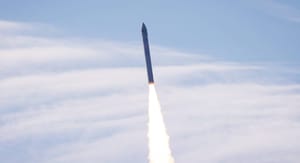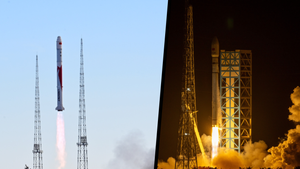
Feb 15, 2024
Intuitive Machines takes aim on the Moon!
After a delay on the 14th of February, a Falcon 9 rocket lifted off from Launch Complex 39A bound for the Moon, the first since Apollo 17! The Falcon 9 was carrying Intuitive Machine's Nova-C lander for the IM-1 mission.
The launch took place at 06:05 am Coordinated Universal Time on the 15th of February from Cape Canaveral, in Florida. This launch was also the three-hundredth launch of a Falcon 9.

For the launch, SpaceX had to make modifications to Falcon 9's ground support equipment to be able to fuel the Nova-C lander with liquid methane and liquid oxygen, it is currently unknown how much the modifications cost Intuitive Machines to add the capability to the rocket. SpaceX was previously unable to load these fuels inside of Falcon 9's fairing but this modification allows for more complex spacecraft to be launched on the extremely reliable rocket, such as Impusle Space's Helios kick-stage.
The booster for this mission is B1060, which flew for the first time on the 30th of June 2020, making its eighteenth flight and landed back at Landing Zone 1 in Cape Canaveral. B1060 has previously flown the following missions: GPS III SV03, Starlink V1.0 L11, Starlink V1.0 L14, Türksat-5A, Starlink V1.0 L18, Starlink V1.0 L22, Starlink V1.0 L24, Transporter-2, Starlink Group 4-3, Starlink Group 4-6, Starlink Group 4-9, Starlink Group 4-14, Starlink Group 4-19, Galaxy 33 & 34, Transporter-6, Starlink Group 5-15, Starlink Group 6-18.

Nova-C is Intuitive Machines lunar lander capable of delivering 130 kilograms of payload to the lunar surface. The lander weighs approximately 1,900 kilograms fully fuelled after separation from its launch vehicle, which places it on a trajectory towards the Moon. The lander is powered by a single engine burning liquid methane and liquid oxygen to generate 0.31 tons of thrust. The lander also features five solar panels to generate electrical power for its onboard systems, four are located on the sides with one on top. The Nova-C lander for the IM-1 mission is also called Odysseus.
The lander is expected to land on the lunar surface no earlier than the 22nd of February 2024 in the Malapert A crater, located at 80.4 degrees South and 3.4 degrees West, near the south pole of the Moon.

Prior to the launch on February 6th Steve Altemus, Intuitive Machines Chief Executive Officer and President, said the following:
“As we prepare to embark on our IM-1 mission to the Moon, we carry with us the collective spirit of perseverance, fueled by the dedication and hard work of everyone on our team,” – “Their tireless efforts have brought us to this moment, where we stand on the precipice of history, humbled by the gravity of our mission, yet emboldened by the boundless possibilities that lie ahead.“
The Nova-C IM-1 mission is also the second mission of NASA's Commercial Lunar Payload Services program, the first was Astrobotic's Peregrine, and is carrying six payloads for the agency.
What are the NASA payloads?
Disclaimer: Payload descriptions come from NASA, Intuitive Machines, and the various companies.
ROLSES

ROLSES, or Radio Observations of the Lunar Surface Photoelectron Sheath, will use a low-frequency radio receiver system to measure the electron plasma
environment on the lunar surface acquire observations of solar and planetary radio sources from the lunar surface, sense near-surface charged dust, and provide a first-ever measurement of the radio environment between 10 kHz and 30 MHz at the lander. Since the Moon does not have a global magnetic field to protect it, charged particles can make it to the lunar surface and create a plasma environment on the lunar surface that will levitate fine dust particles. The plasma environment measurements will provide critical information for Artemis astronauts, and the design of rovers, space suits, and other exploration systems.
ROLSES measurements of radio emissions from the Sun, planets, the galaxy, and even how radio-noisy the Earth is will also provide a much-needed baseline for future sensitive lunar radio astronomy systems.
LRA

LRA, or Laser Retro-Reflector Array, is a collection of eight approximately half-inch retro-reflectors, a unique collection of mirrors that is used for measuring distance, mounted to the lander. The mirror system reflects laser light directly backward to the orbiting spacecraft that emits the laser light to precisely determine the lander’s location on the surface of the Moon. LRAs are valuable because they can continue to be used as precision landmarks for guidance and navigation during the lunar day or night.
NDL

NDL, or Navigation Doppler Lidar for Precise Velocity and Range Sensing, is a LIDAR-based, Light Detection and Ranging, sensor composed of an optical
head with three small telescopes and a box with electronics and photonics. NDL uses lasers to provide precise velocity and range sensing during the descent and landing of the lander. This instrument operates on the same principles of radar but uses pulses of light from a laser instead of radio waves and with very high accuracy.
SCALPSS

SCALPSS, or Stereo Cameras for Lunar Plume-Surface Studies, will capture images of the effects of the lander’s engine plume as it interacts with the lunar surface while the lander is descending, and as the dust plume settles after the spacecraft lands. This information is critical for validating predictive models on how
particles on the lunar surface are moved by rocket engine exhaust and allows scientists to analyze the close-up imagery of the surface of the Moon. Data from SCALPSS can be used for future Artemis vehicle designs to ensure the safety of both the landers and any other surface assets nearby during landing.
LN-1

LN-1, or Lunar Node 1 Navigation Demonstrator, is a small CubeSat-sized S-band radio navigation beacon that will demonstrate autonomous spacecraft positioning to support future lander, surface, and orbital operations. Radio beacons like LN-1 can guide incoming and outgoing spacecraft and landers with precision and reduce fuel consumption. This experiment will leverage NASA’s Deep Space Network for one-way ranging and Doppler tracking to provide real-time position information, like how GPS works on Earth.
RFMG

RFMG, or Radio Frequency Mass Gauge statement, technology uses radio waves and antennae in Nova-C’s tank to measure exactly how much propellant is available. RFMG could be crucial during future long-duration missions that will rely on spacecraft fueled by cryogenic propellants, like liquid hydrogen, liquid oxygen, or liquid methane. These propellants are highly efficient but are tricky to store as they can evaporate quickly, even at low temperatures. Being able to accurately measure spacecraft fuel levels will help scientists maximize resources as NASA moves toward its goal of returning humans to the Moon through Artemis.
What are the commercial payloads?
Omni-Heat Infinity for Columbia Sportswear

In partnership with Intuitive Machines, Columbia is testing the limits of its innovations by sending Omni-Heat Infinity to the Moon. Originally inspired by the space blankets on the Apollo missions, the same Omni-Heat Infinity technology found in jackets on Earth will help protect the Nova-C lunar lander from the extreme temperatures of outer space.
Intuitive Machines and Columbia tested the thermal reflective material to aerospace industry standards. Thermal modeling revealed that Omni-Heat Infinity provides a benefit for heat reflection when used as a panel covering, and that is where the technology will be used on Nova-C. Intuitive Machines engineers incorporated Columbia’s Omni-Heat Infinity thermal reflective technology onto one of Nova-C’s closeout panels to protect Nova-C’s cryogenic propulsion tank.
Embry-Riddle EagleCam

Intuitive Machines co-founder, Steve Altemus, challenged his alma mater to engineer an out-of-this-world selfie when he visited the university in 2019. Students and faculty accepted Altemus’ challenge and created EagleCam, a camera system to capture the world’s first-ever third-person picture of a spacecraft making an extraterrestrial landing. Additionally, the device will test an electrostatic dust-removal system, which could lead to future advances in spacesuit technology. EagleCam was created in the university’s Space Technologies Laboratory.
Eaglecam is designed to deploy off of Nova-C approximately 100ft, or 30m, above the lunar surface and capture images as the spacecraft touches down on the Moon.
Moon Phases by Jeff Koons

As a symbol of human curiosity and the desire to achieve, Jeff Koons: Moon Phases comprises 125 unique artworks, each consisting of 3 components: a sculpture that will be installed on the Moon, a sculpture that will stay on the Earth, and a 'Non-fungible token' that corresponds with the sculptures on the Moon and the Earth. The 125 miniature stainless steel Moon Phase sculptures will be displayed on the Moon in a cube, which was designed and built by 4Space in consultation with Koons. The Moon Phase artworks are associated with individuals who made important accomplishments in human history. The list of names is universal, from various cultures throughout the world, fields, and time periods. Displayed in front of each artwork, the names memorialize the figures.
ILO-X for the International Lunar Observatory Association

ILO-X is a precursor to the International Lunar Observatory Association Hawai’i flagship Moon South Pole Observatory ILO-1. The ~0.6 kg ILO-X instruments, built for International Lunar Observatory Association by Toronto-based Canadensys Aerospace, includes a miniaturized dual-camera lunar imaging suite, one wide field, and one narrow field. It will aim to capture some of the first images of the Milky Way Galaxy Center from the surface of the Moon, as well as perform other celestial astronomy and local lunar environment observations and exploration technology validations, including functionality and survivability in the lunar environment.
Lunaprise for Galactic Legacy Labs

Galactic Legacy Labs aims to establish a secure lunar repository called the Lunaprise in support of Arch Missions Foundation’s billion-year archive, preserving human knowledge for eternity. These messages are called Lunagrams and can be submitted online as text, an image, or both. Music and video files are also accepted. An archive from the nonprofit Arch Mission Foundation, including the English Wikipedia, The Rosetta Project, Long Now Foundation content, Project Gutenberg content, and other cultural archive datasets are also included in the payload.
Lonestar Data Holdings
Lonestar Data Holdings’ payload is working to send increasingly capable data centers to the Moon to meet the needs of its customers for secure data storage and edge processing. Lonestar Data Holdings’ Independence payload represents a key technology demonstration of the company’s Disaster Recovery as a Service utilizing the unique operational properties offered from the Moon. Working with Intuitive Machines, Lonestar Data Holdings is storing digital data on board the Nova-C lander for its customers and transmitting the first documents off the planet for data storage to the Moon while in turn transmitting the first documents back from the Moon.
What is Intuitive Machines?
Intuitive Machines is an American company headquartered in Houston, Texas. The company was founded in 2013 by Stephen Altemus, Kam Ghaffarian, and Dr. Tim Crain.
The company currently has three lunar landing missions planned as part of its lunar program, which will provide lunar surface access, lunar orbit delivery, and communications at lunar distance.




